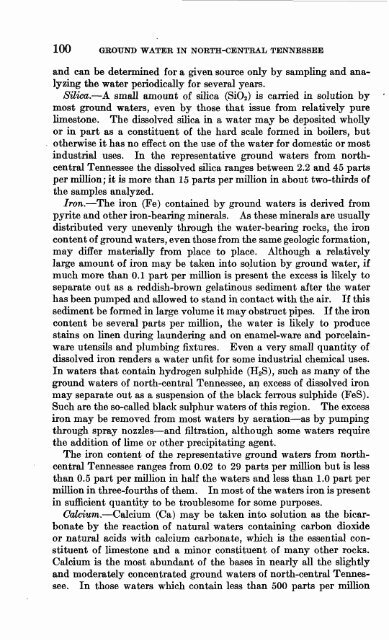GROUND WATER IN NORTH-CENTRAL TENNESSEE
GROUND WATER IN NORTH-CENTRAL TENNESSEE
GROUND WATER IN NORTH-CENTRAL TENNESSEE
Create successful ePaper yourself
Turn your PDF publications into a flip-book with our unique Google optimized e-Paper software.
100 <strong>GROUND</strong> <strong>WATER</strong> <strong>IN</strong> <strong>NORTH</strong>-<strong>CENTRAL</strong> <strong>TENNESSEE</strong><br />
and can be determined for a given source only by sampling and ana<br />
lyzing the water periodically for several years.<br />
Silica. A small amount of silica (SiO2) is carried in solution by<br />
most ground waters, even by those that issue from relatively pure<br />
limestone. The dissolved silica in a water may be deposited wholly<br />
or in part as a constituent of the hard scale formed in boilers, but<br />
otherwise it has no effect on the use of the water for domestic or most<br />
industrial uses. In the representative ground waters from north-<br />
central Tennessee the dissolved silica ranges between 2.2 and 45 parts<br />
per million; it is more than 15 parts per million in about two-thirds of<br />
the samples analyzed.<br />
Iron. The iron (Fe) contained by ground waters is derived from<br />
pyrite and other iron-bearing minerals. As these minerals are usually<br />
distributed very unevenly through the water-bearing rocks, the iron<br />
content of ground waters, even those from the same geologic formation,<br />
may differ materially from place to place. Although a relatively<br />
large amount of iron may be taken into solution by ground water, if<br />
much more than 0.1 part per million is present the excess is likely to<br />
separate out as a reddish-brown gelatinous sediment after the water<br />
has been pumped and allowed to stand in contact with the air. If this<br />
sediment be formed in large volume it may obstruct pipes. If the iron<br />
content be several parts per million, the water is likely to produce<br />
stains on linen during laundering and on enamel-ware and porcelain-<br />
ware utensils and plumbing fixtures. Even a very small quantity of<br />
dissolved iron renders a water unfit for some industrial chemical uses.<br />
In waters that contain hydrogen sulphide (H2S), such as many of the<br />
ground waters of north-central Tennessee, an excess of dissolved iron<br />
may separate out as a suspension of the black ferrous sulphide (FeS).<br />
Such are the so-called black sulphur waters of this region. The excess<br />
iron may be removed from most waters by aeration as by pumping<br />
through spray nozzles and filtration, although some waters require<br />
the addition of lime or other precipitating agent.<br />
The iron content of the representative ground waters from north-<br />
central Tennessee ranges from 0.02 to 29 parts per million but is less<br />
than 0.5 part per million in half the waters and less than 1.0 part per<br />
million in three-fourths of them. In most of the waters iron is present<br />
in sufficient quantity to be troublesome for some purposes.<br />
Calcium. Calcium (Ca) may be taken into solution as the bicar<br />
bonate by the reaction of natural waters containing carbon dioxide<br />
or natural acids with calcium carbonate, which is the essential con<br />
stituent of limestone and a minor constituent of many other rocks.<br />
Calcium is the most abundant of the bases in nearly all the slightly<br />
and moderately concentrated ground waters of north-central Tennes<br />
see. In those waters which contain less than 500 parts per million

















